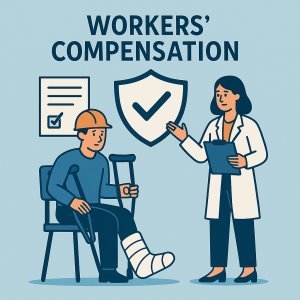
Employers’ Guide—IT Staffing Workers’ Comp
August 5, 2025
Pay-As-You-Go Workers’ Comp for Georgia Security Guard Companies
August 5, 2025In recent years, the retail landscape has undergone a importent transformation with the rise of “dark stores”-warehouse-style facilities dedicated exclusively to fulfilling online orders.While these streamlined operations offer efficiency and convenience for consumers, they also present a unique set of risks and challenges for workers. As the demand for rapid fulfillment intensifies, so too does the need for comprehensive workers’ compensation strategies tailored specifically to the hazards inherent in these environments. This article explores the complexities of workers comp for dark stores, highlighting the distinct occupational risks and the critical considerations for employers, insurers, and policymakers in managing workplace safety and liability within this evolving sector.
Table of Contents
- Workers Compensation Challenges Unique to Dark Store Operations
- Assessing and Mitigating Injury Risks in Warehouse-Style Retail Environments
- Implementing Effective Safety Protocols for Dark Store Employees
- Best Practices for Claims Management and Regulatory Compliance in Dark Stores
- Q&A
- In retrospect
Workers Compensation Challenges Unique to Dark Store Operations
Dark store environments blend the characteristics of traditional retail with the logistical intensity of warehouse operations, creating a distinct set of risks for workers’ compensation. Employees face hazards such as operating heavy equipment,navigating narrow aisles stacked with bulk inventory,and managing continuous high-volume order fulfillment. These conditions can lead to a higher incidence of musculoskeletal injuries, slips, and collisions, demanding tailored safety protocols and claims management. Moreover, the dynamic nature of dark stores – often functioning 24/7 with fluctuating workforce sizes - complicates consistent injury prevention and tracking efforts.
Insurance providers must also grapple with the unique operational realities when assessing claims. The intersection of retail layouts and warehouse machinery means that standard workers’ comp classifications may not fully capture the exposure, affecting premiums and coverage decisions. Common challenges include:
- Ambiguity in job roles: Employees frequently alternate between stocking, packing, and equipment operation, making injury attribution complex.
- Variable staffing: Use of seasonal or temporary workers can impact training quality and injury reporting accuracy.
- Technology integration: Automated systems change the ergonomic and mechanical risk landscape, requiring specialized adjustments in claims strategies.
Assessing and Mitigating Injury Risks in Warehouse-Style Retail Environments
Warehouse-style retail environments, often referred to as dark stores, present unique challenges when it comes to workplace safety. The sprawling layouts, high shelving units, and constant use of heavy machinery increase the likelihood of various injury types, including slips, trips, and falls, and also musculoskeletal disorders from repetitive lifting. To proactively manage these risks, companies must integrate comprehensive hazard assessments that focus on both environmental factors and employee behavior. Regular safety audits combined with employee training can substantially reduce the incidence of workplace injuries by ensuring that all staff are aware of potential hazards and appropriate operational protocols.
Implementing strategic mitigation measures is critical not only for safeguarding workers but also for controlling workers’ compensation claims.Effective approaches include:
- Ergonomic workstations: adjusting packing and picking stations to reduce strain and repetitive motion injuries.
- Enhanced lighting: minimizing dark spots and shadows that contribute to accidents.
- Clear signage and pathways: promoting safe navigation to prevent collisions and falls.
- Routine equipment maintenance: ensuring forklifts and pallet jacks operate safely without malfunctions.
- Emergency response drills: preparing workers for injury scenarios and promoting swift action.
| Risk Factor | Common Injuries | Mitigation Strategy |
|---|---|---|
| Slip and Trip Hazards | Sprains, fractures | Regular floor inspections & anti-slip mats |
| heavy Machinery Operation | Crush injuries, lacerations | Operator certification & equipment checks |
| Manual Lifting Tasks | back injuries, fatigue | Ergonomic training & lift-assist tools |
Implementing Effective Safety Protocols for dark Store Employees
Ensuring the safety of dark store employees requires a multi-faceted approach tailored to the unique challenges of warehouse-style retail environments. Regular risk assessments should be conducted to identify potential hazards such as heavy equipment operation, aisle congestion, and repetitive motion injuries. developing standardized safety checklists and mandatory training sessions for all staff can significantly reduce accidents. Implementing an easy-to-follow reporting system for near-misses and incidents encourages proactive prevention measures and continuous improvement of safety protocols.
Key elements to focus on include:
- Ergonomic workstation design to minimize strain during product handling
- Clear signage and floor markings to improve navigation and avoid collisions
- Regular maintenance schedule for all machinery and equipment to prevent malfunctions
- Emergency drills and first aid training to ensure preparedness in critical situations
In addition, leveraging technology like wearable devices can monitor worker fatigue and alert supervisors to potential risks, thereby enhancing both safety and productivity. A collaborative culture where management and employees are aligned on safety goals fosters accountability and ultimately reduces the frequency and severity of workplace incidents.
Best Practices for Claims Management and Regulatory Compliance in Dark Stores
Effectively managing claims in dark stores requires a proactive approach that prioritizes both safety and regulatory adherence. First, establishing a comprehensive incident reporting system is essential. Encourage employees to report any workplace accidents promptly, no matter how minor, to ensure timely inquiry and mitigation. regular training sessions focused on warehouse safety protocols, proper equipment use, and emergency response can significantly reduce claim frequency. Additionally, incorporating technology such as wearable safety devices and automated hazard detection can provide real-time monitoring that enhances worker protection.
Compliance with evolving regulations demands continuous audit and policy updates. Dark stores must align their operational procedures with OSHA standards and state-specific labor laws to avoid costly fines and reputation damage. Implementing a structured compliance calendar that tracks mandatory inspections, certification renewals, and employee training deadlines helps maintain regulatory discipline. below is a streamlined checklist to assist dark store managers in sustaining best practices:
| Key Compliance Area | Best practice |
|---|---|
| employee Training | Quarterly refreshers on safety and compliance protocols |
| Incident Documentation | Digital logging within 24 hours of occurrence |
| Regulatory Audits | Biannual internal reviews with external validation |
| Equipment Maintenance | Scheduled monthly inspections and prompt repairs |
Q&A
Q&A: Workers Comp for Dark stores - Warehouse-Style Retail Risks
Q1: What are dark stores, and how do they differ from traditional retail outlets?
A1: Dark stores are retail facilities that resemble warehouses and are designed exclusively for fulfillment of online orders, with no walk-in customers. Unlike traditional stores that combine in-person sales with inventory storage, dark stores focus solely on inventory management and order processing, often operating with more industrial layouts and higher automation.Q2: Why is workers’ compensation particularly important for employees working in dark stores?
A2: Employees in dark stores face unique risks due to the warehouse-style habitat, such as heavy lifting, operating machinery like forklifts, repetitive motion injuries, and potential slips or falls amid high shelving. Workers’ compensation protects these workers by covering medical expenses and lost wages resulting from work-related injuries, ensuring financial security and promoting workplace safety.
Q3: What types of injuries are most common among workers in dark stores?
A3: common injuries include musculoskeletal disorders (e.g., back strains, repetitive stress injuries), accidents involving forklifts or pallet jacks, slips, trips, and falls, and also injuries from handling heavy or hazardous materials. These injuries often result from the physically demanding and fast-paced nature of warehouse work.
Q4: How do risks in dark stores compare to those in traditional retail settings regarding workers’ comp claims?
A4: Dark stores typically present higher frequency and severity of workplace injuries compared to traditional retail stores. the warehouse-like setup involves more manual labor and equipment operation, increasing the likelihood of serious injuries. Consequently, workers’ comp claims may be more complex and costly, necessitating tailored risk management strategies.
Q5: What measures can employers in dark stores take to mitigate workers’ comp risks?
A5: Employers should invest in comprehensive safety training, enforce proper ergonomic practices, maintain equipment regularly, implement strict protocols for hazardous tasks, and encourage reporting of hazards or near-misses. Additionally, employers can use safety technology like motion sensors or automated lifting aids to reduce injury risks and lower workers’ comp claims.
Q6: How do insurance providers assess workers’ comp policies for dark stores?
A6: Insurers evaluate factors including the size of the facility, the nature of tasks performed, employee training programs, past claims history, and risk management practices. Because of the higher risk profile, premiums for dark stores may be higher than traditional retail, but discounts are possible through demonstrated safety improvements.
Q7: What should businesses transitioning from traditional retail to dark store models consider regarding workers’ comp?
A7: Businesses must reassess their workers’ comp coverage to ensure it aligns with new operational risks associated with warehouse-style environments. This includes updating risk assessments, revising safety protocols, retraining employees, and consulting with insurers to adjust policies and premiums accordingly.
Q8: Are there any regulatory considerations specific to workers’ comp for dark stores?
A8: Yes. Dark stores must comply with Occupational Safety and Health Governance (OSHA) standards relevant to warehouse operations, along with state-specific workers’ comp regulations. Failure to meet regulatory requirements can result in penalties and increased workers’ compensation liabilities.Q9: How can efficient workers’ compensation management benefit dark store operations?
A9: Efficient management reduces downtime, controls insurance costs, improves employee morale, and enhances overall productivity by fostering a safer workplace. Proactive claims management and risk mitigation strategies help maintain business continuity and protect the bottom line.
This Q&A provides a comprehensive overview of workers’ compensation considerations for dark stores, highlighting the unique risks and proactive strategies needed to manage them effectively in this evolving retail segment.
In Retrospect
as the retail landscape continues to evolve with the rise of dark stores and warehouse-style fulfillment centers, understanding the unique workers’ compensation risks associated with these environments is essential. Employers must proactively address safety protocols, tailor their claims management strategies, and ensure comprehensive coverage to mitigate potential liabilities. By staying informed and adapting their risk management approaches, businesses can better protect their workforce and maintain operational resilience in this rapidly changing sector.
“This content was generated with the assistance of artificial intelligence. While we strive for accuracy, AI-generated content may not always reflect the most current information or professional advice. Users are encouraged to independently verify critical information and, where appropriate, consult with qualified professionals, lawyers, state statutes and regulations & NCCI rules & manuals before making decisions based on this content.







